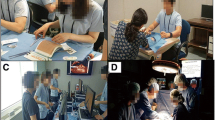Abstract
Background
Surgical skills courses are becoming increasingly popular. This study focuses on their long-term effects.
Participants and methods
Participants in a 1-week general and visceral surgery course were included. Exercises in conventional and laparoscopic surgery were conducted under tutor guidance. Eighteen months after the course at the earliest (18–90), all participants (n = 756) from 1999 to 2005 received a standardized questionnaire on the surgical training situation, the learning success, the implementation of acquired skills in routine clinical practice, and the value of skills courses.
Results
We evaluated 459 of 756 participants (60.7%). The percentage of participants fully confident in their ability to suture a simple and a difficult anastomosis increased from 56.9% and 21.6% before to 93.5% and 59.3% after the course (p < 0.05). An improved surgical technique after the course was reported by 86.9%. Instrument handling changed after the course in 76.9%, and 68.1% stuck to this change. The evaluation showed that 89.5% wanted skill courses to become an integral part of surgical training.
Conclusion
Participants in a general and visceral surgery course profit from long-term modification and improvement of their surgical technique. The course is still rated positively many years later. A 1-week skills course in general and visceral surgery is an attractive module with long-term effects on surgical training.



Similar content being viewed by others
References
Lynge DC, Larson EH, Thompson MJ, Rosenblatt RA, Hart LG (2008) A longitudinal analysis of the general surgery workforce in the United States, 1981–2005. Arch Surg 143(4):345–350 discussion 351
Merten M (2005) Chirurgie: expecting shortage of manpower. Dtsch Arztebl 102(3):A84
Bauer H (2007) Surgery in new structures. Trauma Berufskrankh 9:264–273
Bell RH Jr (2008) Graduate education in general surgery and its related specialities and subspecialities in the United States. World J Surg 32(10):2178–2194
Hwang CS, Pagano CR, Wichtermann KA, Dunnington GL, Alfrey EJ (2008) Resident versus no resident: a single institutional study on operative complications, mortality, and cost. Surgery 144(2):339–344
Markus PM, Horstmann O, Langer C, Markert U, Becker H (2002) Simulation of surgical techniques in graduate education of the surgeon. An analysis of value and effect. Chirurg 73(6):622–627
Gerdes B, Hassan I, Maschuw K, Schlosser K, Bartholomaus J, Neubert T et al (2006) Instituting a surgical skills lab at a training hospital. Chirurg 77(11):1033–1039
Anastakis DJ, Regehr G, Reznick RK, Cusimano M, Murnaghan J, Brown M et al (1999) Assessment of technical skills transfer from the bench training model to the human model. Am J Surg 177(2):167–170
Anastakis DJ, Wanzel KR, Brown MH, McIlroy JH, Hamstra SJ, Ali J et al (2003) Evaluating the effectiveness of a 2-year curriculum in a surgical skills center. Am J Surg 185(4):378–385
Cohen AH, Cohen R, Taylor BR, Reznick RK (1994) Health care system and medical education in Canada. 1. Review of the health care context in a time of change. World J Surg 18(5):672–675 discussion 671
Grober ED, Hamstra SJ, Wanzel KR, Reznick RK, Matsumoto ED, Sidhu RS et al (2004) The educational impact of bench model fidelity on the acquisition of technical skill: the use of clinically relevant outcome measures. Ann Surg 240(2):374–381
Reznick RK (2005) Surgical simulation: a vital part of our future. Ann Surg 242(5):640–641
Sidhu RS, Grober ED, Musselman LJ, Reznick RK (2004) Assessing competency in surgery: where to begin? Surgery 135(1):6–20
Thomas WE (2000) Core skills, courses and competency. Ann R Coll Surg Engl 82(1 Suppl):18–20
Gallagher AG, Smith CD, Bowers SP, Seymour NE, Pearson A, McNatt S et al (2003) Psychomotor skills assessment in practicing surgeons experienced in performing advanced laparoscopic procedures. J Am Coll Surg 197(3):479–488
Tang B, Hanna GB, Carter F, Adamson GD, Martindale JP, Cuschieri A (2006) Competence assessment of laparoscopic operative and cognitive skills: Objective Structured Clinical Examination (OSCE) or Observational Clinical Human Reliability Assessment (OCHRA). World J Surg 30(4):527–534
Rosser JC, Rosser LE, Savalgi RS (1997) Skill acquisition and assessment for laparoscopic surgery. Arch Surg 132(2):200–204
Harden RM, Gleeson FA (1979) Assessment of clinical competence using an objective structured clinical examination (OSCE). Med Educ 13(1):41–54
Halsted WS (1904) The training of the surgeon. Bull Johns Hop Hosp 15:267–275
Semm K (1986) Pelvi-trainer, a training device in operative pelviscopy for teaching endoscopic ligation and suture technics. Geburtshilfe Frauenheilkd 46(1):60–62
Zheng B, Cassera MA, Martinec DV, Spaun GO, Swanström LL (2009) Measuring mental workload during the performance of advanced laparoscopic tasks. Surg Endosc, May 23. [Epub ahead of print]
Rogers DA, Regehr G, Yeh KA, Howdieshell TR (1998) Computer-assisted learning versus a lecture and feedback seminar for teaching a basic surgical technical skill. Am J Surg 175(6):508–510
Xeroulis GJ, Park J, Moulton CA, Reznick RK, LeBlanc V, Dubrowski A (2007) Teaching suturing and knot-tying skills to medical students: a randomized controlled study comparing computer-based video instruction and (concurrent and summary) expert feedback. Surgery 141:442–449
Moulton CA, Dubrowski A, MacRae H, Graham B, Grober E, Reznick R (2006) Teaching technical skills: what kind of practice makes perfect?: a randomized, controlled trial. Ann Surg 244:400–409
Author information
Authors and Affiliations
Corresponding author
Rights and permissions
About this article
Cite this article
Gröne, J., Ritz, JP., Buhr, H.J. et al. Sustainability of skill courses for general and visceral surgery—evaluation of the long-term effect. Langenbecks Arch Surg 395, 277–283 (2010). https://doi.org/10.1007/s00423-009-0568-7
Received:
Accepted:
Published:
Issue Date:
DOI: https://doi.org/10.1007/s00423-009-0568-7




